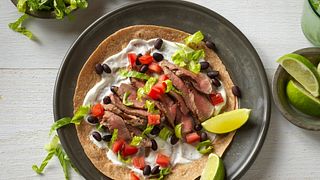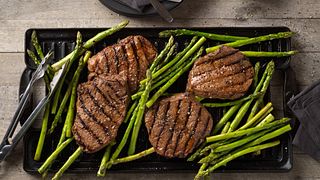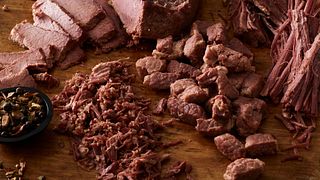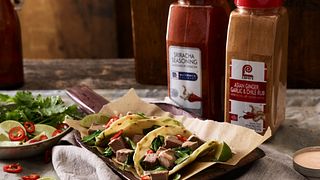Beef Remains Foodservice Mainstay
May 3, 2019
To better understand beef trends at foodservice, Beef. It’s What’s For Dinner., on behalf of the beef checkoff, completes an annual foodservice volumetric study to measure operator purchases and distributor sales of beef and other proteins across all foodservice operator segments.1 Beef accounts for fully 16% of total foodservice food and non-alcohol purchases, making it the most prominent ingredient at foodservice. It spans from the affordable and convenient burger to the high-end steak experience and everything in between. This cornerstone role and associated investment make understanding beef’s trends important.
Overall, animal protein purchases continued to increase in 2018. Total foodservice volumes grew 1.1% to 26.464 billion pounds over the prior year and are up over 4.4% since 2014. Consistent with the overarching trend,2 consumers are enjoying more meat, poultry, fish and seafood at foodservice. While 31% of this volume is chicken and 30% is beef, beef’s wholesale purchase value exceeds that of chicken by 37.6%.
In total, 2018 foodservice beef purchases exceeded 8.028 billion pounds or $31.205 billion. When compared to the prior year, volume was 0.1% lower while dollar purchases increased 3.3%. Given beef’s strong performance at retail and in export markets,3 along with traffic challenges amongst casual dining chain establishments,4 this volume change at foodservice is in-line with available beef supplies. The price inflation, however, implies stronger consumer demand is driving operators’ increased willingness to pay for beef.
Chart 1 shows that restaurants and bars accounted for 70% of 2018 beef foodservice purchases, whereas other commercial and non-commercial segments purchased the balance of beef volume. Over the past five years, this split has ranged from 68/32 to 70/30. The wider 2018 division was driven by beef growth at full-service restaurants (FSR) while price-sensitive non-commercial segment purchases were constrained by price inflation in 2018.
Source: Beef at Foodservice Volumetric Study, Technomic, 2019
The 2018 growth in beef pounds at full-service restaurants was twice that of chicken (132 vs. 68 million pounds), enhanced by a strong economy, improved performance amongst independent and steak-driven concepts,5 and the popularity of iconic and higher-end steaks. Particularly appealing cuts at restaurants in 2018, whether purchased as pre-cut steak or subprimal for further fabrication, included: Filet, Ribeye, Strip, Flank, Flat Iron, and Petite Tender. FSRs also increased their purchases of Brisket and Chuck Roasts as well as Back and Country-Style Ribs in 2018.
Beef’s strong share of total pounds at limited-service restaurants (LSR) (45% of pounds) is of course, driven by the ever-popular and economical burger. Related to this limited-service burger presence, operator purchase volumes are dominated by Ground Beef, followed by pre-cut steaks and then subprimals/roasts (Chart 2).
Source: Beef at Foodservice Volumetric Study, Technomic, 2019
Not surprisingly, these shares shift when price is added to the mix. Whereas 64% of beef pounds were purchased as ground beef, this share fell to 37% of total beef value. Alternatively, pre-cut steaks accounted for 13% of volume and 30% of value. Similarly, roast/subprimal purchases increased from 11% of volume to 18% by value.
Beyond restaurants, 2018 beef dollar purchases remained robust, as steaks, roasts/subprimals and Ground Beef play an important role for operators. Retailer (grocery prepared foods and convenience store) purchases of Ground Beef and strips/dices/shaved beef strengthened, in line with consumer interest in variety, convenience and ethic offerings. Pre-cooked Roast Beef purchases at lodging increased as this segment focuses more on prepared and convenience-oriented options for guests.
All told, beef continues to be a mainstay for foodservice operators. Its versatility by preparation, cuisine type, cut, price point and beyond provide options to meet multiple concepts and needs. For further detail on 2018 and prior year operator beef purchases, please click here.
About the Volumetric Study
Since 2005, Technomic, a leader in foodservice industry research and intelligence, has surveyed the top 250 chain operators along with 700-900 unit-level foodservice operators each September, asking how much of each beef cut or product was purchased in the past year. September wholesale price information is captured, as well. This data is then scaled to represent the entire foodservice industry and is then validated by distributors (broadliners and meat specialists) and processors. All operator segments are included, from restaurants though non-commercial foodservice operations.6 Protein-level data is then summarized, as is beef-specific product form (e.g. Ground Beef, Steaks, Roasts, etc.), primal and cut data.
- Usage and Volumetric Assessment of Beef in Foodservice 2018 Edition, Technomic, 2019.
- USDA World Agricultural Supply and Demand Estimates, April 2019.
- Beef Export Statistics, U.S. Meat Export Federation, April 2019.
- Restaurant Sales Analytics & Insights, Black Box Intelligence, April 2019.
- Foodservice Planning Program, Technomic, January 2019.
- Data for the 5 smallest segments (Bars & Taverns, Recreation, Military, Corrections and Continuous Care Retirement Centers) are only captured in odd-numbered years. Prior year volume numbers are extended forward in even years, e.g. 2017 Bar & Tavern numbers are used for 2018.





